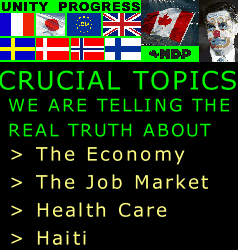weacguy August 17th, 2009 9:19 am
Even a robust public option is just corporate welfare:
Top Ten Reasons the Public Plan is a Bait and Switch
1. It leaves in place the deficient employer based model. As the National Organization for Women noted in their single payer endorsement (July 7, 2009) of the only viable reform model, single payer, many Americans are tied to jobs they don’t like because of the antiquated employer based insurance model. For those switching from one job to another, those wanting to go on strike, those wanting to quit a job, etc. it prevents the ability to move freely as a laborer.
2. It leaves private insurance, a major contributor to administrative inefficiency and bloated bureaucracy, in charge of health care decisions.
3. It only results in about 10% of the savings that would accrue were single payer to be enacted. That’s assuming 50% of Americans can enroll---an optimistic figure (Jacob Hacker’s assumption that Congress has drastically scaled back to a tiny plan). Since hospitals and doctors will still have to deal with 1300 insurance companies little savings will result by adding a public option, reports Dr. Don McCanne of the Physicians for a National Health Plan, March 26, 2009, www.pnhp.org. 24% of hospital budgets go to billings (only 12% in Canada) and this wouldn’t change under any version of the public option. As Drs. Steffie Woolhander and David Himmelstein note, the bureaucratic savings of the public plan option “would be miniscule”. (The New York Times, Room For Debate, June 18, 2009).
4. It does not pay for itself, unlike single payer, requiring a huge tax increase. As the State Legislators for Single Payer Healthcare (including initiating sponsor WI State Sen. Mark Miller) note there is “no increase in total health care spending” with single payer. Instead of everybody in, nobody out, an inclusive approach based on solidarity, public option pits the wealthy against poor, taxing the rich to provide subsidies to help poor people buy overpriced, insufficient private health insurance. In the mainstream media this is being framed as the liberals taxing the rich for their liberal plan to force everyone into big government care, when In reality, the tax proposal would be used to shore up the private insurance system, giving them more customers and higher profits. In her June 24 Congressional testimony, Dr. Woolhander estimated that it will cost 200 billion annually to pay for health insurance costs for those who cannot afford it. That’s a much larger tax increase on the wealthy.
5. It becomes part of the same failed private model: co pays, deductibles, denials of some necessary procedures, services and medications. Coverage and benefits will be similar to the private plans due to inability to control costs. (see no. 3) “The ‘Public Plan Option’: Myths and Facts available at www.pnhp.org and see the excellent analysis, “Health Care Reform 2009: A Train Wreck in Slow Motion by Dr. John Geyman, July 21, 2009 available at www.pnhp.org/blog.
6. It leaves millions uninsured. Mandates have already failed in states where it has been tried, mostly recently in Massachusetts. And, the model for a health insurance exchange, the Federal Employee Health Benefit Program, leaves hundreds of thousands of federal workers uninsured, and does not control costs (Nicholas Skala, Congressional Progressive Caucus testimony, June 4, 2009).
7. It segregates patients into two groups: healthy patients who will be aggressively pursued by insurance companies and sicker/older patients who will end up in the public plan. The public plan will not make private insurers honest. Private insurers compete by denying (necessary) coverage. The public plan will either emulate this model, or quickly go under as it becomes overburdened by the sicker, older patients, reports Dr. Woolhander (June 24 House Subcommittee on House Energy and Commerce).
8. Projected savings claimed by Wisconsin Citizen Action (based on a Lewin group study of Hacker’s original PO proposal) are not based on historical trends with public option plans that have already failed in every state where they have been tried. (see Wisconsin Cost Savings under National Health Care Reform by Dr. Robert Kraig available at citizenactionwi.org) The HMO-Medicare history shows that public plans do not keep private insurers “honest”. “A quarter century of experience with public/private competition in the Medicare program demonstrates that the private plans will not allow a level playing field.” The Public Option Con, www.pnhp.org
9. Private insurers will still continue to deny claims and as a result, a major issue, bankruptcy due to health costs will remain unaddressed. In their June 2008 endorsement of single payer, the U.S. Conference of Mayors noted that “millions with insurance have coverage so inadequate that a major illness would lead to financial ruin.” www.usmayors.org/resolutions/76th_conference/chhs_03.asp
10. The public option will not allow for choice of provider unlike single payer since the public option will need to appeal to a provide network to obtain services for its subscribers. “Patients will still have a limited choice of provider restricted by networks” as a Physicians for a National Health Program fact sheet states.
“The ‘Public Plan Option’: Myths and Facts available at www.pnhp.org
UNITY-PROGRESS COMMENT
All true about the "public option".
This is both bad news and good news actually.
On the one hand, the political implication of no public option is that we are a lot closer to full third world status than most would have believed.
On the other hand, true, pure, real progressives will be happy about the demise of the public option, because it hastens the day where the whole system collapses once and for all, and/or it increases the odds that single payer can come into existence one state at a time, with the states most resistant to descending into third world status first in line to enact it. (Vermont, Hawaii, and possibly Minnesota come to mind.)
[The above was in response to this article.]






No comments:
Post a Comment